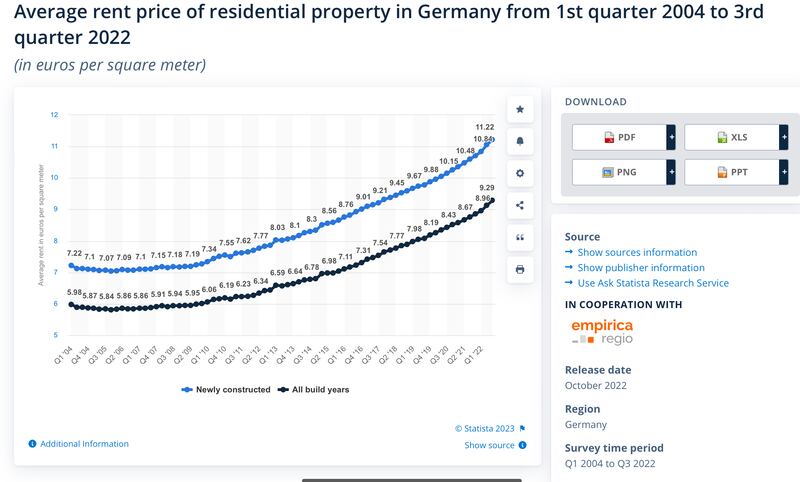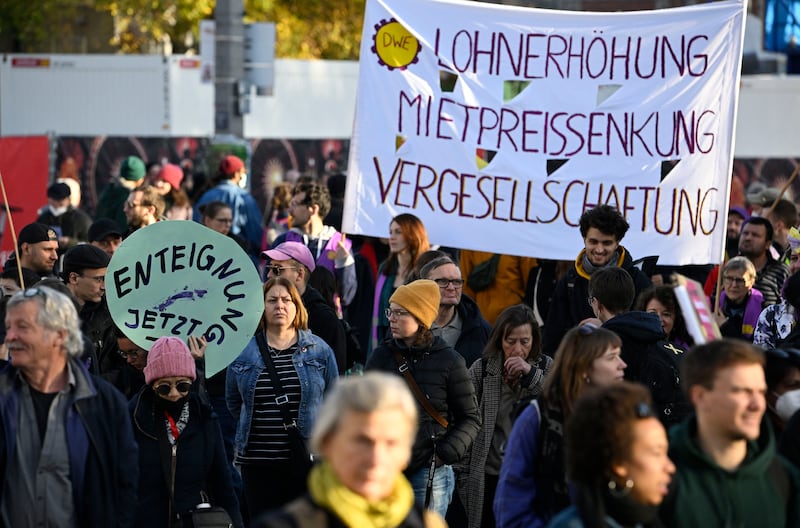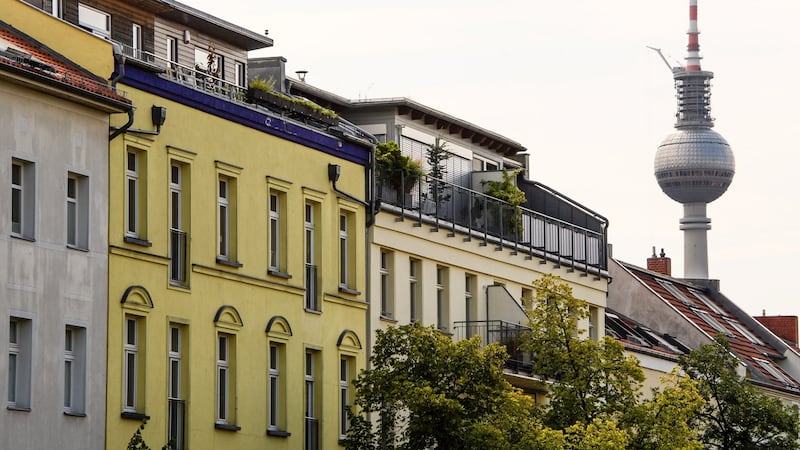On a chilly April day, the queue of hopefuls snaked 150m around the block, all hoping for the same thing: a 74 m2 three-room apartment, with a separate kitchen and bathroom for €1,074 a month. After an hour online, the landlord had 600 queries and took the advertisement down. An hour after the original viewing time, the apartment was gone and the queue of hopeful tenants went home hopeless.
What sounds like another day in the life of a flat hunter in Dublin is the new reality, too, in Berlin. For much of the post-wall period, the German capital was the big easy. Anyone arriving in the city 20 years ago had their pick of apartments, at bargain basement rates, and landlords often happy to throw in a free fitted kitchen. Anything for a tenant.
That was once upon a time. Ask anyone looking for an apartment now and the terms most often heard about the rental market are “broken”, “dysfunctional” and “desperate”.
“Finding an affordable apartment in Berlin was never as difficult as today,” noted Berlin Hyp, a property financier in the capital, in a recent report.
READ MORE
There is no shortage of data to prove the point. Since 2014, average rents have increased by 55 per cent, with rents in popular areas increasing by twice that.
In the first three months of this year alone, average rents sought on one big property platform rose 27 per cent to €12.55 per m2, the common metric for calculating rent costs. (So about €990 a month for a 79m2/850 sq ft two-bed apartment).
Berlin has gone from sleeping beauty of German real estate market to the second most expensive rental city behind Munich (€17.39/m2), with an average of 200 applicants for every Berlin apartment advertised.
Compounding a serious housing shortage are tales of financial and sexual exploitation from those offering flats – or rooms – to let.
“Nestled in the corner of an image of the room,” wrote one traumatised Berlin flat-hunter in a recent online post, “lay a reflection of the male photographer’s genitals.”
Rent cap

Experts point to a number of factors for the current situation: a lack of new builds, a surge of new arrivals since the end of the pandemic and a market correction after a failed attempt by Berlin’s city state to cap rents.
That February 2020 cap, cheered by the city’s 1.5 million tenants, saw Berlin impose a freeze on rents – until, after 14 months, a court ruled it “void in its entirety” in April 2021.
German states have no legal competence to decide on such issues, the constitutional court ruled, leaving tenants scrambling twice over: to pay their original, unfrozen rent and the rent they saved during the 14-month experiment.
A lack of new apartments remains the Achilles heel of the Berlin property market. After a population slump in the early 2000s, as many Berliners moved out to the greener plains of surrounding Brandenburg, the city’s population began growing again in 2012. Every year until 2020, about 30,000 people arrived on average, without new apartments being built.
During that time, additional shocks changed the market fundamentals. The euro crisis saw wealthy Europeans and institutional investors discover and move in on what they viewed as Berlin’s undervalued property market. Flush with cash, or servicing expensive mortgages, they hired lawyers to find loopholes in Berlin tenancy laws to shift sitting tenants with low rents or, through expensive renovations, maximise the potential for rent increases. The most recent shock – the war in Ukraine – has seen an additional 100,000 people settle in the city, pushing demand and rents still higher.

“Apartments are being bought now to generate profit, but that is totally contrary to the wish for affordable rents,” says Andrej Holm, a leading sociologist and property market analyst. “If this continues,” he warns, “low- and middle-income households will soon no longer be able to live here.”
Like other analysts, Holm says the Berlin housing crisis is a crisis of social housing supply.
Crisis of supply
On top of challenges common to other big European cities, the additional factor in the Berlin housing crisis dates back to the turn of the century. A scandal involving a city-owned bank and the ruling Christian Democratic Union (CDU) ripped a €55 billion hole in the city balance sheet. To pay its bills, the near-bankrupt city sold off social housing for ready cash.
Berlin’s social housing stock, a socially progressive reserve built up in the 1920s – and rebuilt and expanded in the 1950s and 1960s – slumped from 264,000 units in 2001 to just 92,000 today.
Two decades on, the same CDU has been voted back into power in Berlin’s city-state senate. With the Social Democratic Party (SPD), it is promising 20,000 new apartments a year, including 5,000 new subsidised social units.
But tenant lobby groups say this is nowhere near enough to address a crisis which, as elsewhere, is most acute at the affordable end of the market.
Unusually for residents of a capital city, Berliners have incomes lower than the national average. Every second household has an annual income below €16,800 and is entitled to a WBS (residency eligibility) certificate. This grants them access to the rent-controlled municipal flat market – in theory at least.
In 2020 and 2021, however, 85,000 new WBS certificates were issued, but only 3,000 subsidised flats built. With WBS applications remaining steady, the new government’s promise to build or subsidise 5,000 affordable units annually is cold comfort for those seeking affordable apartments.
“We need new builds,” says Wibke Werner, head of Berlin’s leading tenants’ association, “but you have to look closely in which price segment they are being built”.
Instead of larger, affordable family flats, Berlin’s property websites are filled with sprawling €6 million penthouses for well-heeled foreign investors.
Developers say servicing the higher end of the market is the only way they can turn a profit because of the spiralling cost of land. One recent analysis showed land in the eastern Friedrichshain district leapt from €460 per m2 in 2008 to €5,500 now – a rise of 1,000 per cent.
There is no prospect of change any time soon, as developers do battle on several fronts: record land prices, a shortage of skilled labour and a chronic backlog in Berlin’s processing of planning permits.
Meanwhile Berlin’s new state government has yet to commit to implementing a successful 2021 referendum, in which 57 per cent of voters backed a demand for the city to expropriate corporate landlords with more than 200,000 housing units in their portfolio.
Citing constitutional concerns – Nazi-era abuses created high postwar hurdles on property seizures – the city is waiting for the recommendations of an expert panel.

But organisers of the 2021 referendum accuse Berlin politicians of playing for time. They point to a new study which found that rents in corporate-owned blocks were 20 per cent more expensive than rents in municipal housing stock. Returning these flats to public ownership would reduce rents across the board to lower levels, the paper’s authors argue, resulting in a €200 million saving for Berlin tenants.
[ Young Portuguese defer dreams as housing crisis bitesOpens in new window ]
Buying back privately-owned housing units would not solve all problems, the authors add, “but has the potential to be very effective”.
“From the perspective of supply of social housing, this instrument should be used,” says Dr Matthias Bernt, a Berlin-based planning analyst and co-author of the report for the left-wing Rosa Luxemburg Foundation.
Critics of the plan say buying back the flats – at an estimated cost of €6 billion – would not create any extra housing units. And they point to other risks: last week it emerged that 11,000 apartments the city bought back from corporate owners in 2022 are riddled with asbestos, a serious health risk, requiring expensive renovation. In total, one in seven of Berlin’s state-owned apartments are likely to contain asbestos, according to the same parliamentary query.
Much of Berlin’s public housing stock mirrors the wider property market: a toxic health risk.
[ Irish Abroad: I’d love to move home to Ireland but I can’t afford toOpens in new window ]
Tenant rights in Berlin and Germany

Berlin is a city of tenants, with just 17 per cent living in their own four walls, compared to 42 per cent nationwide. (By comparison, Ireland had a home ownership rate of 70 per cent in 2021).
Every tenant in Germany is protected by a legal notice of contract termination of at least three months. The longer you reside in the apartment, the longer the notice period becomes: six months’ notice if you have rented a flat for five – eight years and nine months’ notice for any period longer than that.
For regular, open-ended leases, a landlord can increase the rent by a maximum by 15 per cent over a three-year period. This increase, based on standard rate tables for each district, has to be justified and can be contested by tenants. Some landlords charge a so-called Staffelmiete, or “stepstone rent”, with predefined annual rent increases.
Landlords can pass on modernisation costs to a tenant, increasing rent by 8 per cent annually. Fixed-term rental contracts, often involving furnished apartments, are excluded from rent controls.
There are limited grounds for cancelling a tenancy: most common is provable personal need for the apartment. In some cases, the notice period on such cancellations, depending on how long the tenant has lived in the apartment, can be as long as 10 years.
As the rental market has tightened in recent years, Berlin tenancy organisations have noticed a marked rise in such cancellations – with apartments often ending up on short-term rental sites.



















